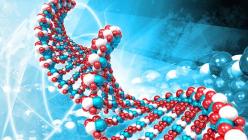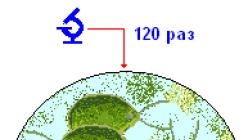The appearance of these plants is unusual: they have neither stems, nor leaves, nor roots. Many associate their life with water, but they also live on land: on the surface of the soil, in its thickness, on trees, rocks, in caves and even in cities - on sidewalks, damp walls of buildings, roofs... these are algae.
Algae are the oldest group of lower unicellular and multicellular plants that contain chlorophyll and produce organic substances through the process of photosynthesis. Algae appeared on Earth in the Proterozoic - approximately 2.7 billion years ago. They play an important role in nature: they form organic substances, participate in the calcium and silicon cycles, and purify water; Algal waste products destroy rocks, contributing to the formation of soils.
Microscopic algae are part of plankton. These tiny organisms swim in a thin surface layer of water and move with currents. Phytoplankton (algae) produces organic substances, due to which the rest of the living world of water bodies exists.
What are we doing? Place a drop of “blooming” water on a glass slide and cover with a coverslip.
What we are seeing. Find and examine unicellular algae at low magnification: Chlamydomonas (a pear-shaped body with a pointed anterior end).

What are we doing? Drain some of the water from under the coverslip with a strip of filter paper.

What we are seeing. Examine an algae cell at high magnification.
What to watch. Find the algae cell: membrane, cytoplasm, nucleus, chromatophore. Pay attention to the shape and color of the chromatophore. Observe the operation of the pulsating vacuole.
36. Complete the “Meaning of Plants” chart
In nature
Air– enrich with oxygen, absorb carbon dioxide.
for animals– food source – predators eat.
In human life
Source- food, raw materials.
raw materials for industries– cereals, fruits and berries, medicinal, feed and technical
Cognitive– high-yielding varieties of cultivated plants, resistant varieties of cultivated plants
Aesthetic- the plants are very beautiful
37. Complete the definition.
Botany is the science of plants.
38. Compare the structure of lower and higher plants. Fill the table.
|
Group of plants |
Structural features |
Representatives |
|
Inferior |
have no roots or stems |
seaweed |
|
Higher |
have roots |
trees |
39. After completing the laboratory work “Structure of green (unicellular) algae,” indicate which algae cells are shown in the pictures. Label their main parts.
1 – flagella
2 – shell
3 – cytoplasm
4 – core
5 – chromatophore
6 – red eye
Conclusion: All algae - lower plants - are identical in structure. Chlamydomonas has flagella and a red eye.
40. Indicate which multicellular algae are shown in the pictures. Label their main parts.
1 – shell
2 – chromatophore
3 – cytoplasm
4 – core
41. Fill out the table.
|
Algae group |
Habitat |
Structural features |
Representatives |
|
Green unicellular algae |
Fresh water bodies |
One cell, maybe. flagella, ocellus |
Chlamydomonas |
|
Green multicellular algae |
Seas, oceans, fresh water bodies |
Ulotrix |
|
|
Brown algae |
Seas, oceans |
kelp |
|
|
Red algae |
Seas, bodies of water |
Multicellular marine plants |
scarlet |
42. Complete the diagram. The meaning of algae.
In nature:
– enrich the hydrosphere with oxygen;
- are food for aquatic animals;
- indicators of pollution and disease.
In human life:
- chemical industry;
- iodine, alcohol;
- agar-agar;
- food dishes;
- chlorella, chlamydomonas, water purification.
43. In the picture, label the components of the lichen thallus.
1 – algae cells
2 – mycelium
Conclusion: lichens contain algae cells, mycelium.
44. Fill out the diagram.
Lichen forms:
- scale, Bacidia;
- leafy, Parmelia;
- bushy, bearded plaid.
45. Why are lichens able to settle in the most barren places?
Answer: Because they only need water to live, they will have enough of it from rains, fogs, etc.
46. Label what is indicated in the figure with numbers:
1 – male;
2 – female specimen of moss;
3 – box with spores;
4 – stem;
5 – leaves;
6 – rhizoids (root outgrowths)
47. After completing the laboratory work “Structure of moss”, make a drawing and a conclusion.
Conclusion: the body of mosses is divided into stems and leaves, and they reproduce by spores and belong to higher plants.
48. Compare algae and mosses. What complications have occurred in the structure of mosses compared to algae?
Mosses have organs where spores mature; F, M box with spores. There is a stem, leaves, rhizoids. Mosses are higher spores, and algae are lower.
49. Complete the laboratory work “Structure of spore-bearing horsetail.” Label what is shown in the figure with numbers:
1 – roots
2 – stem
3 – spikelet with spores
Conclusion: horsetail has roots, a stem, and spores. This is a spore-bearing plant and belongs to the higher ones. Spores ripen in the spikelets.
50. After completing the laboratory work “Structure of a spore-bearing fern”, indicate what is indicated in the figure by numbers:
1 – shieldweed
2 – stem
3 – group of sporangia
4 – cross section of a sorus leaf
5 – disputes
Conclusion: ferns have spores, sporangia, stems, leaves, sori. These are higher plants.
51. Fill out the table “Comparative characteristics of conifers.”
52. Complete the laboratory work “Structure of conifer needles and cones.” Based on the results of laboratory work, fill out the table.

53. Fill out the diagram “Life forms of angiosperms.”
Plant shapes:
– trees (ash, maple, oak)
- shrubs (lilac, rose hips)
- herbs (dandelion)
54. Look at the picture in the textbook and explain which plants are called annual, biennial and perennial. Give examples of such plants.
1. Tree - birch - perennial, because aboveground and underground organs do not die off every year.
2. Shrubs (shrubs) – perennial.
4. Herbs – annual, biennial and perennial.
55. Describe several plants known to you in terms of life expectancy and fruiting characteristics. Fill the table.
TECHNOLOGICAL LESSON MAP
MBOU "Secondary School No. 2"
Teacher: Melnikova Svetlana Nikolaevna
Class 5
Subject Biology
Lesson #22
Lesson topic: Algae - unicellular and multicellular. Structure, life activity, reproduction. Variety of algae. The role of algae in nature, human use. Laboratory work No. 7 “Study of the structure of algae” Diversity of algae.
Lesson type: Lesson of “discovering” new knowledge
Activity goal: developing the ability of students in the process of laboratory work.
Educational goal: expanding students’ conceptual base about the diversity and structural features of algae by including new elements.
Formation of UUD:
Personal actions: students develop elements of communicative competence in communication and cooperation with the teacher and class students in the process of educational activities (self-determination, meaning formation, moral and ethical orientation)
Regulatory actions: (goal setting, planning, forecasting, control, correction, assessment, self-regulation)
Cognitive activities: students learn and formulate conclusions about algae as representatives of lower plants, their characteristic features, develop an understanding of the taxonomy of organisms (general educational, logical, problem formulation and solution)
Communicative actions: planning educational cooperation, asking questions, resolving conflicts, managing a partner’s behavior, the ability to express one’s thoughts with sufficient accuracy and completeness in accordance with the tasks and conditions of communication
No. Lesson stage
methods and techniques Teacher actions Activities
UUD students
1 Organizational moment
(Motivation for learning activities). Greetings. Positive work attitude. Greeting from teacher K, L2 Updating and recording individual difficulties in a trial educational activity. Check of knowledge. Frontal conversation - Talk about the diversity of plants.
- What characteristics are inherent in representatives of the Plant kingdom?
- What are tissues and organs? The essential characteristics of plants are identified. P, K3 Identification of the location and cause of the difficulty. Check of knowledge. Frontal conversation - What is the difference between representatives of lower and higher plants? There are higher and lower plants. P, K4 “Discovery of new knowledge” (Building a project for getting out of a difficulty (goal and topic, method, plan, means). Teacher’s story with demonstration of tables, slides and video clips. Near the Bahamas at a depth of 269 m, where 99.9995 is absorbed % of sunlight, brown algae were discovered in 1984. The brown algae Macrocystis pyriformis grows 45 cm per day and reaches a length of 160 m. Our planet is supplied with oxygen by plants and algae produce the most of it. In the process of photosynthesis, the algae chlorella releases the amount of oxygen significantly exceeding its mass. Chlorella's ability to produce large amounts of organic matter and release a lot of oxygen allows scientists to assume that chlorella can be used in spaceship greenhouses as a source of oxygen and food for astronauts.
Algae are also found in habitats with extreme conditions - in the ice of mountain peaks and the Arctic. In the hot springs of Kamchatka, the temperature of which reaches 75.7C (27 species of algae were discovered). Currently, more than 100 species of algae have been discovered growing on the surface of snow and ice. The color of snow can be green, red, blue, brown, yellow and even black - depending on the species that predominate among snow algae. Working with the text and illustrations of the textbook, collaborating with classmates to discuss the characteristic features of algae as a group of lower plants.
PC,
5 Statement of the educational task Teacher's story with demonstration of tables, slides and video clips. Today in the lesson we must learn what are the structural features and vital functions of plants in the algae department. Compare these plants with previously studied ones, identify features of adaptation to environmental conditions.
Guys, we already know that algae are the first plants on Earth that synthesize organic substances from carbon dioxide and water in the light. They are the oldest plants on earth, so scientists believe that modern land plants evolved from ancient algae.
What characteristics unite all algae into one group? Identify the essential features of algae. Distinguish between representatives. Explain the role of algae in nature and human life P, K, L
6 Primary consolidation
(Implementation of the constructed project). Working with TsOR. Virtual educational laboratory virtulab.net Characteristic signs of algae.
- Most algae are inhabitants of rivers, lakes, and seas.
- There are about 30 thousand algae in nature.
- Algae are unicellular and multicellular.
- They belong to lower plants.
- They have no roots, no stems, no leaves.
- They reproduce by simple cell division, spores, and germ cells.
- The most ancient plants on Earth.
- Capacity for photosynthesis.
1. Study of the structure of a single-celled representative of the class Green algae - Chlamydomonas.
1.1. Familiarize yourself with the structure of Chlamydomonas. Determine the main elements of its structure. 1.2. Determine what functions the specified structures perform.
2. Study of the structure of a multicellular representative of the class Green algae - Spirogyra.
2.1. Familiarize yourself with the structure of Spirogyra. Determine the main elements of its structure.
2.2. Determine what functions the specified structures perform.
PC.
7 Independent work with self-test according to the standard. LR Prepare the microscope for work and a micropreparation with the aquarium algae Lagarosiphon (Curly Elodea). Find 1 cell and study it carefully. Determine how the contents of the cell are delimited from the external environment, whether there is a nucleus and other organelles characteristic of a plant cell (which ones?). Pay attention to the shape and color of the chromatophore (Fig. 102 of the textbook). What is its function? Try to detect cells of a different structure or tissue. Is it easy to do? Why? Draw the structure of a Spirogyra cell in your notebook. Label the membrane, cytoplasm, nucleus, vacuole, chromatophore. Compare the structure of Spirogyra with the structure of unicellular algae. Note the similarities and differences. Identify the essential features of algae. Distinguish between representatives. Explain the role of algae in nature and human life K, P, R, L8 Information about homework, instructions on how to complete it Reflection on learning activities in the lesson (result). Virtual educational laboratory virtulab.net CONCLUSION What conclusion can we sum up regarding our LR? 3. Give a comparative description of the structure of the studied organisms.
ETC
9 Write them down in the table:
P
D.z. P.1
http://www.virtulab.net/index.php?option=com_content&view=article&catid=42%3A7&id=149%3A2009-08-23-11-36-00&Itemid=103
Laboratory work No. 7
on the topic: “Structure of single-celled greens”
Purpose of the work: 1) To become familiar with the structure of unicellular green algae.
2) Determine the main elements of their structure and what functions
they do.
3) Give a comparative description of the structure of the studied organisms.
Equipment: instruction card with pictures, diagrams and tables, §18
Progress
1. Study of the structure of a single-celled representative of the class Green algae - Chlamydomonas.
1.1. Familiarize yourself with the structure of Chlamydomonas. Determine the main elements of its structure.
1.2. Determine what functions the specified structures perform.
Exercise 1.
Consider the image of a representative of the Green Algae Chlamydomonas department. Identify the main elements of its structure using the terms listed below.
Flagella, nucleus, photosensitive eye, contractile vacuoles, chromatophore, membrane, cytoplasm
Task No. 2.
Determine what functions are performed by different structures of the Chlamydomonas cell.
Copy the table into your notebook! Fill it out using the options below, adding them to the correct places in the table. 
Genetic information provides cell shape, excretion of excess water, photosynthesis, movement, light perception.
2. Study of the structure of a single-celled representative of the class Green algae - chlorella.
2.1. Familiarize yourself with the structure of chlorella. Determine the main elements of its structure.
2.2. Determine what functions the specified structures perform.
Task No. 3.
Consider the image of a representative of the Green Chlorella algae department. Identify the main elements of its structure using the terms listed below.

Chromatophore, nucleus, cytoplasm.
Draw a picture with ready-made symbols in your notebook!
Task No. 4.
Determine what functions are performed by different structures of the Chlorella cell.
3. Give a comparative description of the structure of the studied organisms.
Task No. 5
Compare the structure of the studied organisms. Find similarities and differences in cell structure.
4. Draw a conclusion on the work done.



